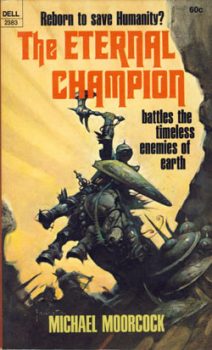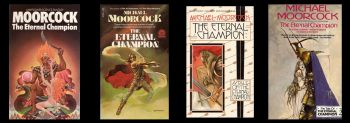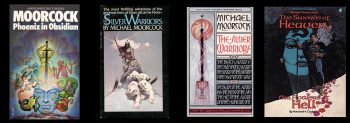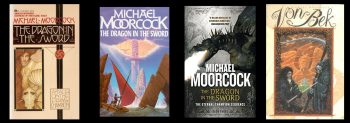Erekosë and Me

Michael Moorcock’s Erekosë saga is contained in three novels, and graphic novel, and a couple of short stories which were incorporated into his novels of Elric, Corum, and Hawkmoon. I was first introduced to the character when I came across him in those interpolated adventures and I sought out his own novel, The Eternal Champion. When I first read it in the early 1980s it became one of my favorites of Moorcock’s novels. At the time, I had some difficulty tracking down the second novel, The Silver Warriors (original title Phoenix in Obsidian), which I eventually did at a used bookstore in New Haven, Connecticut. I then had to wait several years for the publication of The Dragon in the Sword, which linked Erekosë with Moorcock’s von Bek family. It was only much later that I came across the graphic novel, The Swords of Hell, The Flowers of Heaven, written by Howard Chaykin, which is set between Phoenix in Obsidian and The Dragon in the Sword.
The series begins with John Daker, a married man with a child, who lives in London, although his wife and child are forgotten throughout the books. After a series of troubling dreams, Daker finds himself pulled into a different world, where he is informed by King Rigenos that he is Erekosë, the Eternal Champion of Humanity, and must help destroy the evil Eldren who threaten their existence. Yearning to return to the life he knew as Daker, Erekosë accepts his role unquestioningly and adapts quickly to his new existence. In many ways, he is a troubling aspects of the Eternal Champion.
Although his summoning is similar in many ways to the manner in which Corum is summoned at the beginning of The Bull and the Spear published a couple years after The Eternal Champion, one of the major differences between the two characters is that Corum was native to his world and Daker was not. Enough of Daker remained within Erekosë, especially at the beginning of the novel that as a human raised on twentieth century earth the idea of being surrounded by slaves should have caused some issues. Similarly, for someone for whom World War II was such a recent memory, the idea of leading a genocide against the Eldren should have caused some moral qualms.

Erekosë is eventually able to accept his place in the world and almost completely put his John Daker past behind him once he has almost successfully exterminated that Eldren and completely killed off humans. He then spends the next century with his Eldren lover, Ermizhad, and her brother trying to rebuild the world he had worked to destroy until summoned, once again, to be the savior of another world in Phoenix in Obsidian (also published as The Silver Warriors).
Having learned a little from his existence as Erekosë, Urlik doesn’t entirely trust the first people he meets, the Lord Spiritual of Rowernarc, Bishop Belphig, and the Lord Temporal, Shanosfane. His mistrust of Belphig proves correct and he eventually finds himself allies with Bladrak Morningspear against Belphig and the Silver Warriors.
Following the events of Phoenix in Obsidian, Urlik finds himself pulled again from his world, although not having found Ermizhad in his current incarnation, he leaves the world much more willingly than he had as Erekosë. His new incarnation in The Swords of Heaven, The Flowers of Hell is that of Clen of Clen-Gar. In this guise, the champion finds that he must defend the Dream Marches from both the forces of Heaven and Hell, the two civilizations on either side of it. While Erekosë found a home for himself with Ermizhad at the end of The Eternal Champion and Ulrik accepted his place at the end of Phoenix in Obsidian, Clen of Clen-Gar never fully becomes part of his world and the graphic novel ends with him boarding the Black Ship that carried him on his adventures against Agak and Gagak in The Sailor on the Seas of Fate and against Voilodion Ghagnasdiak in The Vanishing Tower and The King of the Swords.

More than fifteen years after the novels were published, Moorcock returned to the series with a final volume, The Dragon in the Sword. By this time, he had also published The War Hound and the World’s Pain in 1981 and The City in the Autumn Stars, which dealt with the Von Bek family. Moorcock brought the two series together by making a scion of the Von Bek family, Urlich, a companion to the Eternal Champion’s latest incarnation, Prince Flamadin, which must face off against his sister Princess Sharadim.
One of the things that appealed to me upon my first reading of The Eternal Champion and Phoenix in Obsidian is the amount of fanservice, as it would now be called, that Moorcock included in the books. Throughout his dreams, Erekosë was inundated with the names of other aspects of the Champion Eternal, and while some of them were familiar to me, others were not. In that long-ago pre-internet era, the simple recitation of names became a roadmap to finding other novels that Moorcock had written that included those aspects of the character.
Similarly, while earlier novels hinted at each aspect’s role in the Cosmic Balance, often in the guise of the champion’s advisor, whether known as Jhary-a-Conel, the Warrior in Jet and Gold, or some other aspect of the Eternal Companion, this series, especially Phoenix in Obsidian is where Moorcock most fully explained how the different aspects of the character, including the Eternal Champion, the Black Sword, the Eternal Companion, and the Eternal Consort fit together.
In The Eternal Champion, Erekosë questions whether he is being punished for some unknown crime. He continues this musing in Phoenix in Obsidian in his guise of Urlik Skarsol. At no point does Erekosë consider that the crime he is being punished for is the genocide of two races in The Eternal Champion. Eventually, his actual crime is revealed in Phoenix in Obsidian, and while it makes sense within the cosmology of Moorcock’s Cosmic Balance, overall it feels like a lesser crime to the genocide, for which Erekosë never shows any remorse.
The first civilization that Urlik Skarsol comes into contact with, the inhabitants of Rowernarc, are aware they are living in the end of times on a world that is quickly dying. Let by the Lord Spiritual, Bishop Belphig, the have given themselves over entirely to a sybaritic existence, in which almost everything is consensual and nothing is considered amoral. A year after Phoenix in Obsidian was published, Moorcock would publish An Alien Heat, the first volume of his Dancers at the End of Time series which takes an alternative look at a civilization that is living with the knowledge that their world is coming to an end.

Of the three novels that comprise the trilogy, The Dragon in the Sword made the least impact on me. I remembered Von Bek’s presence and that there was a scene set in Nazi Germany (actually, I remembered that sequence as being larger and more central to the story than it was). What struck me upon re-reading the novel is that it is more complex than the earlier books, which isn’t surprising given that it is about twice as long as the earlier books. While the Eternal Champion often fights against the forces of Chaos, which in Moorcock’s worlds do not necessarily equate to evil or bad, in The Dragon in the Sword, he also finds himself fighting against evil, with Princess Sharadim standing in for the evil of the Nazis that Von Bek is fighting against as well as the forces of Chaos that the Eternal Champion fights against.
If one were to look for the platonic ideal of a Moorcock fantasy novel, some of the ingredients for inclusion would be a masterful use of nomenclature, horrifying creatures, and interesting landscapes. Taken as a whole, the three books in this sequence check all those boxes, however, they don’t all have everything. The Eternal Champion focuses on Erekosë’s role in the war between the humans and the Eldren and there is a dearth of creatures. Moorcock makes up for that lack in Phoenix in Obsidian and The Dragon in the Sword. The latter two books also check off the intriguing landscape boxes.
When taken as a whole, the least interesting aspect of the Eternal Champion to appear in the novels is really the core to the entire series. Passing through the identities of Erekosë, Urlik Skarsol, Clen of Clen-Gar, and Prince Flamadin, the Champion begins and ends as John Daker, whose personality is most seen through Ulrich Von Bek’s eyes since he can relate to that aspect of the Champion the best, even if Daker is something of a blank slate for the reader.
 Steven H Silver is an eighteen-time Hugo Award nominee and was the publisher of the Hugo-nominated fanzine Argentus as well as the editor and publisher of ISFiC Press for 8 years. He has also edited books for DAW, NESFA Press, and ZNB. His most recent anthology is Alternate Peace and his novel After Hastings was published in 2020. Steven has chaired the first Midwest Construction, Windycon three times, and the SFWA Nebula Conference 6 times. He was programming chair for Chicon 2000 and Vice Chair of Chicon 7.
Steven H Silver is an eighteen-time Hugo Award nominee and was the publisher of the Hugo-nominated fanzine Argentus as well as the editor and publisher of ISFiC Press for 8 years. He has also edited books for DAW, NESFA Press, and ZNB. His most recent anthology is Alternate Peace and his novel After Hastings was published in 2020. Steven has chaired the first Midwest Construction, Windycon three times, and the SFWA Nebula Conference 6 times. He was programming chair for Chicon 2000 and Vice Chair of Chicon 7.
Interesting essay, Steven! I have long been a fan of the first Erekose novel, but the second and third didn’t do much for me. It’s been a long time since I re-read them, though.
I don’t recall – was there a Daker/Erekose story in the Pawns of Chaos anthology?
C. Dean Andersson’s “The War Skull of Hel” is an Urlik Skarsol story. And the two poems in the anthology (Alexandra Honigsberg’s Awakening-A Symphony and James S. Dorr’s Trail-Ways) are both tributes to the Cosmic Balance which reference numerous aspects of the Champion, Companions, and locations.
Great essay! I just ordered trade paperback editions of three Erekose novels, for revisit, to see how they hold up for me. Early Elric tales and the 6 Corum novels are my favorites. Moorcock’s The Ice Schooner is due for a revisit, too.
I previously wrote similar articles for Black Gate about Elric and Corum. As with these books, they didn’t quite match my memories. For the Corum books, I remember preferring the original trilogy, but when I re-read them, I reversed my opinion. These articles are usually spaced out by a couple of years, but I’m thinking I may tackle either The Dancers at the End of Time or Oswald Bastable next.
The earlier columns can be found at:
https://www.blackgate.com/2017/11/24/elric-and-me/
https://www.blackgate.com/2020/10/27/corum-and-me-the-disappointment-of-the-swords/
https://www.blackgate.com/2020/11/08/corum-and-me-the-redemption-of-the-scarlet-robes/
I reread all three a couple of years back. Definitely enjoyed the first two more than the third, although Moorcock was a better writer by the time he was writing Dragon in the Sword; but it was much more of a von Bek book than an Erekosë book.
Good to learn more about the graphic novel; I’ve seen it listed on Amazon (it got reprinted recently) but wasn’t quite sure what it was or how it fit into the larger story.
The second Corum series covers the same ground (and there’s a similar vibe to Prince Caspian) but for whatever reason the opening chapters of the first book have always stuck in my mind – how it must feel to be a long-dead hero, summoned back to life. I started to read it again last year, but quickly lost interest. I guess the story lacks a certain dramatic tension once you know how it’s going to turn out? I have fond memories of The Ice Schooner/Phoenix in Obsidian, but maybe not enough to re-read it, whereas I remember The Dragon in the Sword as being a late addition which – like you say – left little or no impression. And I’ve never even heard of The Swords of Heaven, the Flowers of Hell!
The Swords of Heaven, the Flowers of Hell is a graphic novel that was written by Howard Chaykin instead of Moorcock, but is considered canonical. It was out of print for several years, but in 2018 Titan reissued it as part of their Michael Moorcock Library of graphic novels.
Great article! I love the first two books. A slight correction- THE ICE SCHOONER is an excellent novel in its own right but was not originally called PHOENIX IN OBSIDIAN. You rightly say later on that its variant title was THE SILVER WARRIORS.
The Ice Schooner and Phoenix in Obsidian are two different novels. Phoenix in Obsidian became The Silver Warriors when it was published by Dell in the US.